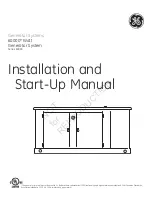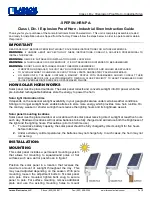
TP-5700 7/93
9
Section 3 Location
The composition of the mounting pad should follow
standard practice for the required loading. Common
specifications call for 2500-3000 psi (176-211 kg/cm
2
)
concrete reinforced with eight-gauge wire mesh or
number 6 reinforcing bars on 12-inch (30-cm) centers.
The total weight of the mounting pad should be at least
equal to the weight of the generator set (a density of 150
lbs. per cubic foot [68.4 kg per 0.03 m
3
] for concrete can
be used for this calculation). Suggested concrete
mixture by volume is 1:2:3 parts of cement, sand, and
aggregate. A layer of 8-10 inches (21-26 cm) of sand or
gravel should surround the pad for proper support and
isolation of a pad located at or below grade. All
generator sets should be anchored to concrete with
bolts buried in the surface of the pad. Expansion-type
anchors are not acceptable.
Note:
Always refer to the dimensional drawings for the
generator and accessories when considering
placement of conduits and fuel lines. Dimensions
are provided on these drawings for rough-ins and
stub-ups of electrical and fuel connections.
3.4 Vibration Isolation
Mounting bases for generator sets 30kW and larger are
typically made from “I” or “C” section fabricated steel
with a width of 2-3 inches per channel. Length varies
with the size of the unit, resulting in a static load on the
mounting base of 10-25 psi (0.703--1.758 kg/cm
2
) if the
total bottom surface of the channel is in contact with the
mounting base. All generator sets should have vibration
isolation between the engine-generator and skid or
mounting base. See Figure 3-5. This may consist of
neoprene or combination spring and neoprene isolators
between the engine-generator and skid, or spring-type
mounts between the skid and mounting pad. An
advantage of factory-installed mounts between the
engine-generator and the skid is that engine-generator
alignment is not affected by stress induced in handling,
shipment, or mounting on an uneven surface. A less
rigid skid may be used, reducing weight and installation
time. All connections between the generator and
mounting base such as conduits, fuel lines, exhaust
piping, etc., must have flexible sections to prevent
breakage and isolate vibration to the generator set.
Generator sets 350 kW and larger are usually mounted
directly to a structural steel base. For these units, the
manufacturer’s
recommended
vibration
isolators
should be installed between the base and mounting
pad. Because of the reduced mounting surface area of
these individual mounts, the static load on the mounting
surface will increase to the range of 50--100 psi
(3.515--7.03 kg/cm
2
).
The vibration isolation efficiency of neoprene pad-type
mounts is approximately 90%. When installed at or
below grade, this degree of isolation will prevent
transmission
of
objectionable
vibration
to
the
surrounding structure. Spring-type isolators can be
expected to provide isolation efficiency of 98%. This
type of mount may be desirable for above-grade
installations.
In some critical applications where the generator set is
installed above grade or where earthquake-proof
mounts are specified, it may be necessary to install
spring-type vibration isolators under the generator set
mounting base. Check state and local codes for such
requirements. Accessory vibration mounts should be
installed at the locations of the standard predrilled
mounting holes.
3
1
2
TP-5700-3
1. To engine-generator
2. Skid cross member
3. Neoprene vibration isolator
Figure 3-5
Neoprene-Type Integral Vibration
Isolators
Summary of Contents for 20-2800 kW
Page 1: ...Industrial Commercial Residential Generator Sets Models 20 2800 kW TP 5700 7 93d Installation ...
Page 12: ......
Page 18: ...TP 5700 7 93 6 Section 2 Load and Transport Notes ...
Page 22: ...TP 5700 7 93 10 Section 3 Location Notes ...
Page 36: ...TP 5700 7 93 24 Section 5 Exhaust System Notes ...
Page 55: ......
















































